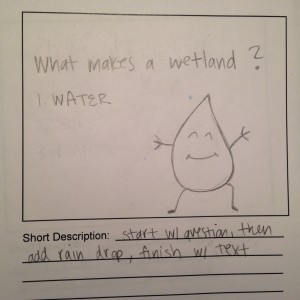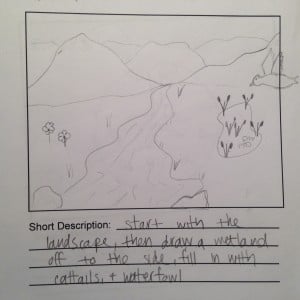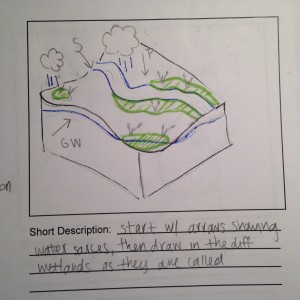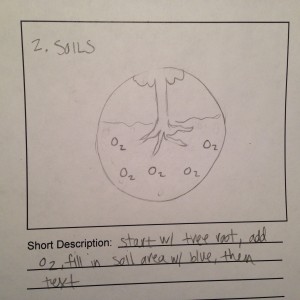Author Archives: Pamela
What Makes A Wetland A Wetland? – Draft 1
What Makes a Wetland a Wetland?
Project Update: During some informal conversations with friends and family, I realized there is much less understanding of what a wetland is than I had originally thought. So I decided I would like to focus my project primarily on what exactly makes something a wetland (i.e., hydrology, soils, and plants). I have copied the first draft of my script below, and some draft sketches for the animation. I still need to work out a few kinks, and transitions between topics, but this draft covers the basic framework of what I would like my audience to learn.
I am still struggling with how to end the animation. First of all, it is entirely possible that this script is too long for a 2-3 minute video. Aside from that, I can’t decide what theme to end on. I think it is really important to reinforce why wetlands are important – so that’s how I currently end my script. But I also really want to convey how changing climate affects wetland hydrology (not yet in the script). I don’t think I have enough time to cover both ecosystem functions and wetland vulnerability, so if I had to choose one, which should it be?
Script 1.0
- What makes a wetland a wetland? Well the simplest answer is water.
- Wetlands are not completely dry, nor are they bodies of water such as a lake, pond, river, or stream. Wetlands are areas of land either permanently, or periodically saturated with water.
- Sources of water to wetlands include precipitation, runoff, groundwater, and tides.
- While many wetlands are found in transitional zones between upland and aquatic ecosystems, for example next to a river or lake,
- Wetlands can also form anywhere on the landscape with an accumulation of water such as surface depressions that collect rainfall and runoff, or areas where groundwater discharges to the land surface
- The development of characteristic wetland soils, and the growth of specially adapted wetland plants depends on the presence of water.
- In most non-wetland soils, oxygen is readily available to plant roots and oil bacteria. However, in saturated soils water displaces oxygen, leading to anaerobic, or oxygen-limited conditions. These are called hydric soils
- In fact, decomposition in anaerobic soils is what gives wetlands their characteristic rotten egg smell.
- Plant species have varying tolerance of saturated soils.
- Species such as cattails are almost always found in wetlands, while other species such as red maple are equally likely in wetland and upland habitats
- Wetland plants, also known as hydrophytes, have evolved special adaptations that allow them to survive and grow in low-oxygen hydric soils.
- Wetland water levels, or hydrology, can range from permanently to rarely flooded. Some wetlands may have a shallow layer of standing water, while others may be muddy, or even appear dry for much of the year. However, as long as saturated conditions persist long enough to develop hydric soils and support wetland plants, the area is considered a wetland.
- There are many different types of wetlands depending on the hydrology – movement of water, soils, and plant species found there.
- For example, marshes are permanently or temporarily flooded wetlands, often dominated emergency vegetations such as cattails or marsh cordgrass.
- While swamps are forested areas dominated by woody vegetation such as bald cypress and tupelo trees, and subject to seasonal patterns of inundation.
- Although once viewed as stinky, insect-ridden wastelands, we now know that wetlands perform many important ecosystem functions.
- Wetlands act as a natural filter to improve water quality. Often described as nature’s kidney’s, wetlands remove excess nutrients, sediment, and pollutants from our waterways, just like kidney’s filter toxins from our blood
- Wetlands also provide protection from floods and storm surge, and plants provide food, habitat, refuge, and nursery grounds for many fish, birds, invertebrates and small mammals.
Animation Image Ideas:
First Image – Happy Raindrop
Wetlands are not completely dry, nor are they bodies of water . . .
Wetland Water Sources
Hydric Soils
Project Proposal – What Makes a Wetland?
Defined as first- and second-order streams, headwaters and their adjacent wetlands establish the beginning of a river network. Located at the interface between uplands and surface water networks, headwater wetlands intercept shallow ground water and surface runoff, acting as a natural filter to improve downstream water quality. Important ecosystem functions provided by headwater wetlands include sediment retention, flood attenuation, and the removal of pollutants/excess nutrients. Headwaters also contribute to regional biodiversity by providing habitat/refuge, and sustain downstream aquatic and riparian biota by exporting essential products such as food, nutrients, and woody debris. As compared to higher order streams, the loss or degradation of headwater wetlands is expected to have a disproportionate impact on downstream water quality.
Hydrology is the single most important factor driving the structure and function of wetlands, including headwater systems. Changes in hydrologic cycles resulting from land use and climate change have contributed to the degradation of streams, wetlands, and other aquatic ecosystems throughout the nation. The consequences of altered hydrology have been studied extensively in many aquatic ecosystems, however it is unclear to what extent land use and climate change will affect the hydrologic regime of headwater wetlands, particularly in flat coastal landscapes such as the coastal plain of Virginia.
Despite no net loss policies and specific guidance for mitigation of wetland impacts, Virginia continue to lose wetlands and ecosystem service capacity through both permitted activities and natural processes. My dissertation research seeks to inform the conservation and management of Virginia’s headwater wetlands by 1) identifying which wetlands are most vulnerable to climate change in the coastal plain of Virginia and 2) describing how the character and condition (i.e., land use) of headwater catchments influence their vulnerability to climate change stressors.
While direct wetland impacts such as filing and draining are immediately obvious, the indirect hydrologic impacts due to land use and climate change that I study require some understanding of wetland hydrology. An important concept fundamental to my research is the movement of water to and from headwater wetlands. One component of this work involves modeling water table fluctuations that contribute to the formation of wetlands in the coastal plain. The soil saturation conditions required to establish and maintain a wetland are consistent between all wetland types – the main differences being how the water is transported to and from the wetland. Therefore I would like to develop a product that teaches the fundamentals of wetland hydrology, in other words, what makes a wetland a wetland?
I plan to create a short (2-3 minute) whiteboard animation describing the hydrology of wetlands that could be used as an educational tool in schools and for the general public. I expect this product would be most appropriate for middle and high school aged students, and would complement lessons on the water cycle and/or wetlands. However, since it would not require in depth understanding of the water cycle, it could also be used in outreach events such as VIMS Marine Science Day. In addition to describing basic wetland hydrology, this video would focus on illustrating the hydrologic connectivity of wetlands to watersheds and downstream ecosystems. Other topics that I may cover include describing how hydrology influences the capacity of wetlands to perform ecosystem functions, and demonstrating how temperature and precipitation alter watershed/wetland hydrology.




